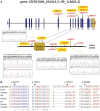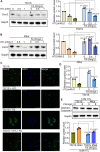Double whammy: the genetic variants in CECR2 and high Hcy on the development of neural tube defects
- PMID: 37424722
- PMCID: PMC10324518
- DOI: 10.3389/fgene.2023.1189847
Double whammy: the genetic variants in CECR2 and high Hcy on the development of neural tube defects
Abstract
Introduction: Neural tube defects (NTDs) are serious congenital malformations. The etiology of NTDs involves both genetic and environmental factors. Loss of CECR2 in mice has been shown to result in NTDs. Our previous study indicated that high homocysteine (HHcy) levels could further reduced the expression level of CECR2. This investigation aims to explore the genetic influence of the chromatin remodeling gene, CECR2, in humans and determine if HHcy can have a synergistic effect on protein expression. Methods: We conducted Next-Generation Sequencing (NGS) of the CECR2 gene in 373 NTD cases and 222 healthy controls, followed by functional assay application to select and evaluate CECR2 missense variants and subsequent Western blotting to identify protein expression levels. Results: From the analysis, we identified nine rare, NTD-specific mutations within the CECR2 gene. Significantly, four missense variants (p.E327V, p.T521S, p.G701R, and p.G868R) were selected via functional screening. The E9.5 mouse ectodermal stem cell line NE-4C, transfected with plasmids expressing p.E327V, p.T521S, p.G868R variants or a recombinant harboring all four (named as 4Mut), exhibited notable reductions in CECR2 protein expression. Furthermore, exposure to homocysteine thiolactone (HTL), an extremely reactive homocysteine metabolite, amplified the reduction in CECR2 expression, accompanied by a significant increase in the apoptotic molecule Caspase3 activity, a potential NTD inducer. Importantly, folic acid (FA) supplementation effectively counteracted the CECR2 expression decline induced by CECR2 mutation and HTL treatment, leading to reduced apoptosis. Discussion: Our observations underscore a synergistic relationship between HHcy and genetic variations in CECR2 concerning NTDs, thereby reinforcing the concept of gene-environment interaction phenomena in NTD etiology.
Keywords: CECR2; apoptosis; homocysteine; mutation; neural tube defects.
Copyright © 2023 Bai, Jiang, Liu, Liu and Zhang.
Conflict of interest statement
The authors declare that the research was conducted in the absence of any commercial or financial relationships that could be construed as a potential conflict of interest.
Figures





Similar articles
-
High Homocysteine-Thiolactone Leads to Reduced MENIN Protein Expression and an Impaired DNA Damage Response: Implications for Neural Tube Defects.Mol Neurobiol. 2024 Oct;61(10):7369-7383. doi: 10.1007/s12035-024-04033-7. Epub 2024 Feb 22. Mol Neurobiol. 2024. PMID: 38386135 Free PMC article.
-
Genetic screening and functional analysis of CASP9 mutations in a Chinese cohort with neural tube defects.CNS Neurosci Ther. 2018 May;24(5):394-403. doi: 10.1111/cns.12797. Epub 2018 Jan 24. CNS Neurosci Ther. 2018. PMID: 29365368 Free PMC article.
-
Genetic backgrounds and modifier genes of NTD mouse models: An opportunity for greater understanding of the multifactorial etiology of neural tube defects.Birth Defects Res. 2017 Jan 30;109(2):140-152. doi: 10.1002/bdra.23554. Birth Defects Res. 2017. PMID: 27768235 Review.
-
Role of chromatin remodeling gene Cecr2 in neurulation and inner ear development.Dev Dyn. 2011 Feb;240(2):372-83. doi: 10.1002/dvdy.22547. Dev Dyn. 2011. PMID: 21246654
-
The role of Vitamin B12 and genetic risk factors in the etiology of neural tube defects: A systematic review.Int J Dev Neurosci. 2021 Aug;81(5):386-406. doi: 10.1002/jdn.10113. Epub 2021 Apr 22. Int J Dev Neurosci. 2021. PMID: 33851436
References
LinkOut - more resources
Full Text Sources

